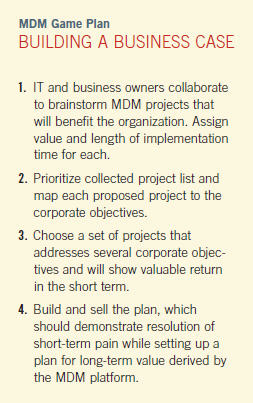CASE STUDY - Selling Master Data Management to the C Suite

By Jim Walker, Senior Marketing Manager, Initiate Systems, Inc.
Company Overview
A diversified financial services company offering a broad array of credit, savings, and loan products to customers in the U.S., UK, and Canada.
The Challenge
This company faced a significant challenge in substantiating the business case for MDM. However, using some best practices for selling the project, they successfully acquired funding and increased visibility within the executive level of the company. This case study outlines their approach and provides a basic game plan for getting your MDM project sold in the C-suite.
The Solution
There are a few key concepts that helped the MDM project leaders build and sell their successful MDM business plan. First, they demonstrated the value of their project in business terms and mapped this to corporate priorities. Second, the plan provided a clear definition of short-term value while painting a picture for ongoing, incremental value over time.
Mapping Projects to Priorities
By mapping their MDM project to corporate objectives, the project leaders were able to demonstrate expected value that executives could categorize and understand.
To get started, this organization gathered a cross-functional group of both IT and business owners to gain a common understanding of MDM and then outline the impact for their respective groups. The result of this meeting was a “greatest hits” of MDM projects categorized under corporate priorities:
Priority: Increase Customer Satisfaction and Retention
- Increase products per customer through improved marketing of cross-sell, up-sell offers
- Consolidate CRM activity and data across lines of business (LOBs)
- Provide consolidated customer account statements and accurate, consistent customer information through all channels and at all touch points
- Create the “right” products for the “right” customers
Priority: Reduce Costs
- Consolidate service centers and reduce customer service wait times by providing consolidated customer information to sales representatives
- Reduce marketing costs by avoiding redundant mailings
- Consolidate third-party data, eliminating overlap and saving license costs
Priority: Identify and Mitigate Risk
- Derive accurate customer profitability and risk profiles
- Implement cross-account and LOB collections and recoveries
Priority: Comply with Regulations
- Maintain a single source for customer privacy preferences across systems and LOBs (opt in/opt out)
- Comply with anti-money laundering and “know your customer” regulations and initiatives
Constructing the Plan
Once the list was compiled, the next step was to identify a set of projects that would demonstrate the greatest value and could be implemented quickly. This “short time to value” set was accomplished by compiling three identified projects across three different corporate priorities. The phase one business plan contained these three objectives:
- Consolidate CRM activity and data across LOBs
- Derive accurate customer profitability and risk profiles
- Manage customer privacy preferences centrally
Short-Term Pain, Long-Term Gain
This comprehensible set of projects/values outlined a quick time to value. The MDM team augmented this section of the business plan with a list of all potential projects and outlined how the first phase project institutes an MDM foundation that additional projects can be built upon in the future. The team presented the complete “greatest hits” list, assigning each to a subsequent phase so the executives could see future value. This allowed the MDM team to:
- Demonstrate incremental value over time
- Allow the initial business case to fund an enterprise wide MDM infrastructure
- Help executives envision value and short-term gains, while understanding long-term goals
- Provide smaller, detailed business cases with the projects people can rally around
- Facilitate commitment to dates and set clear, obtainable milestones
Conclusion
After a successful phase one, the customer has started to provide value on phase two projects. An MDM infrastructure using service-oriented architecture (SOA) is in place and the project has transformed their business processes. Selling this strategic asset to executives is a challenge, but with some careful planning and consideration, it can be successful.
For a free white paper on this topic, click here and choose the title “Master Data Management as ‘Plan B’: Why Your Data Warehouse, CRM, ETL, and EII Solutions Are Better with MDM.”